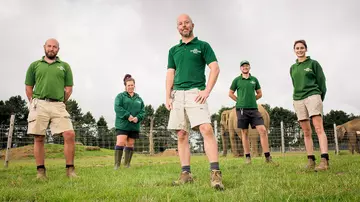
Our head elephant zookeeper Stefan Groeneveld takes us behind the scenes with the elephants, and gives us the lowdown on how new male Ming Jung is settling in.

Elephants learn almost everything from each other but, as Keeper Stefan Groeneveld explains, our herd has a lot to teach us too...
Watching Elizabeth, the youngest of Whipsnade’s elephant herd, throwing sand in the air, it’s hard to believe she’s already four years old. Weighing in at 1,400kg, nearly the weight of four horses, it doesn’t seem long ago she was dashing through the legs of the adults, just reaching their knees.
Now, with the arrival of Ming Jung, the handsome young bull elephant from Antwerp Zoo, keepers hope to hear the heavy pitter patter of baby elephant feet again soon. That is, if Ming Jung can pick up on the delicate signals required in the art of elephant seduction.
“People forget that animals have to learn all of life’s lessons too,” says Stefan Groeneveld, Head Elephant Keeper at the Zoo. “Elephants, in particular, learn everything from each other.”
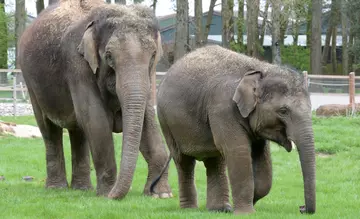
Becoming an adult bull elephant
This certainly applies for 13-year-old Ming Jung, who has some rather essential learning to do. Having recently arrived from a bachelor group, this is the first time as an adult that he’s socialised with female elephants.
“He’s a little bit inexperienced at the moment,” Stefan explains. “He still has to learn about when a female is able to get pregnant.” Ming Jung will need to learn to recognise smells and behaviours from the rest of the herd – which might sound complicated to those of us who use calendars and apps to track our fertility. For now, what he lacks in experience, he’s certainly making up for in enthusiasm. “Female elephants are only fertile for two to three days every few months but, following their introduction, Ming Jung kept trying to mate with them for two weeks,” says Stefan, unable to hide a smile.
The towering bull elephant may look big but, according to Stefan, he still has some growing up to do. “He’s still very young and likes playing, so you’ll see him using the mud wallows, squeaking around in the pool and playing with his sand mounds. When he grows up and gets bigger he’ll become a lot more serious and make far less squeaky noises.”
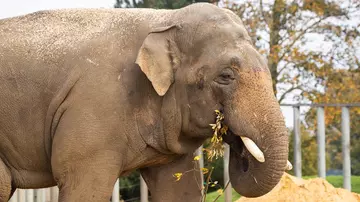
Our elephant family
Elephants learn almost everything from being a part of the herd. When they’re born, their trunks don’t reach the ground. If they did baby elephants, inexperienced with their long, dextrous noses, would trip over them. Instead, they learn how to use these incredible, arm-like appendages from older elephants who demonstrate how to forage for food and suck up water.
“Elephants are completely family orientated,” explains Stefan, who’s worked with the giant mammals for more than 20 years. “The females look after each other and their babies. The herd is so important because if elephants watch a calf being born, being fed and being taught what to do, then they’re prepared for the future. It’s not a shock when suddenly, after the confusion of labour, they have this tiny living thing to care for.”
This will be the case if, as the team hopes, Donna breeds successfully with Ming Jung. “Donna and Elizabeth are really close, so if Donna has a baby this will give Elizabeth a great opportunity to learn how to care for a calf herself.”
And of course, there’ll be the rest of the herd on hand to help, including Donna’s mum Kaylee, who is a good teacher for the calves.
Then there’s Lucha. “We always call her Auntie Lucha,” says Stefan, “because she’s very helpful when the calves are born. She’ll get them between her front legs and walk off with them, giving mum a break!”
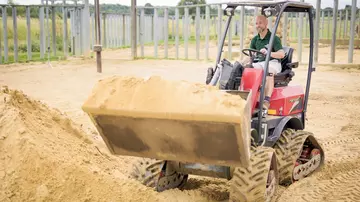
Learning to Change
Stepping back and allowing the herd to do their thing, with as little keeper intervention as possible, is part of the team’s vision for the herd.
“It’s a little bit like having kids,” Stefan says, “you can hold their hand the whole time, and never let them climb a tree, but ultimately you want them to be independent. We want these elephants to do what they want to do, not following or fitting into our routines, but behaving like elephants should. Eating when they want, playing when they want – just being elephants.”
And how are they working to achieve this? “By learning!” says Stefan. The elephant team spend hours painstakingly studying the herd, watching their night-time CCTV, monitoring what they’re eating and how they’re eating, their movements, dynamics and relationships... the list goes on. “Modern zookeeping isn’t just about shovelling poo and keeping animals fed, but about understanding animals and their needs – and adapting to them. We want to see their dynamics, how they work together, and learn from them.”
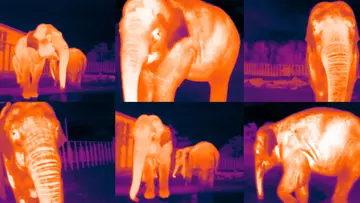
A Future for Elephants
By constantly adapting, the team is leading the way, introducing new enrichment, sand mounds, mud pits, increasing barriers for privacy, and staying hands-off with the herd apart from for medical procedures. Although all these little changes continue to increase the quality of life for Whipsnade’s much-loved elephants here and now, they also serve a greater purpose in the long run.
By nurturing a healthy, independent herd with carefully managed breeding, as part of the European Endangered Species Breeding Programme, Whipsnade’s elephants could one day help their endangered cousins repopulate in the wild.
Elephant conservation tech developed at the Zoo
Asian elephants, throughout Southeast Asia, are threatened by habitat destruction and conflict as people and wildlife increasingly vie for space. With numbers falling, wild elephants face the ever-greater threat of extinction. ZSL, and other conservation charities, are working with communities to find peaceful solutions for people and wildlife, but with mounting pressures, zoos are becoming an important lifeline for the species.
“If Asian elephants become extinct we want to play our part in reintroducing them back into the wild,” says Stefan. “Of course, it’s not as simple as taking two elephants from Whipsnade and plonking them into Thailand, there’s lots of steps in between. But if we have elephants that are behaving as naturally as possible then they’re much better equipped to be reintroduced. And that is one of the many ways we might be able to help in the future.”
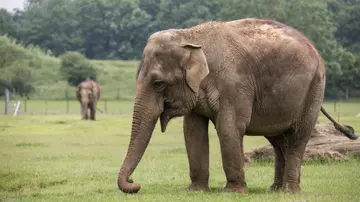
How to become an Elephant Keeper
Stefan has been at Whipsnade Zoo for nine years and knew he wanted to work with elephants from the age of four. Growing up in the Netherlands, he was encouraged by his grandfather, who recognised his passion at a young age. They would go to farms, forests and their local zoo in Rotterdam. “I was obsessed with everything to do with elephants,” he says. “Even then, becoming an elephant keeper was the only thing I could imagine doing.”
By the time he was in his teens, Stefan called Rotterdam Zoo asking for advice about training for his dream job. He laughs when recounting the initial phone call. “It wasn’t very encouraging! They told me: ‘in the Netherlands we’ve got about 20 elephant keepers and 16 million
people – so we suggest you look for another profession!’”
Unperturbed, he persisted, calling them back and asking what university course they recommended. Years later, having taken every opportunity to volunteer and do work placements, he had his first full time job: working with elephants at Beekse Bergen safari park.

Twenty years, and four zoos later, he’s still working with the animals he loves, with the same passion and now a wealth of experience behind him. His grandad’s encouragement is not forgotten either. “He really showed me that if you have kids with an interest in something, you can help them develop it and support them in their passion. Whatever my siblings and I wanted to do, he would try to help us with it.”
It’s part of Stefan’s mission to share that encouragement. He sees talking with visitors and sharing knowledge as a vital part of his work. “We look after these animals in the best possible way, but the other part of the job is the bigger picture of sharing what we’re doing here. Talking to a visitor and then seeing them walk away filled with excitement for these animals, knowing more about elephants, their conservation, and how we look after them, is one of the most rewarding parts of this job.”
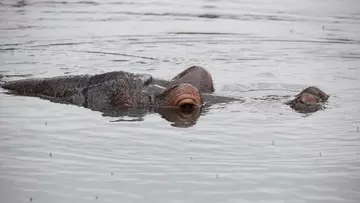
Inspiring new conservationists
As for Stefan’s own kids, they’ve grown up with the elephants visiting once or twice a week.
Myla, his middle child at three, is showing all the signs of an animal enthusiast herself. “She loves animals,” he says with a smile “During lockdown she had a butterfly kit where you care for native caterpillars as they metamorphose into butterflies before being released. It was amazing to see her explain what chrysalises are and understand their lifecycle.
“If there’s a spider in the house we want the kids to look at it, handle it carefully and put it outside, not think ‘there’s a bug let’s squash it.’”
Whether in the Zoo or at home, Stefan sees it as his responsibility to care for wildlife. The team’s work to ever-improve the lives of Whipsnade’s herd and safeguard the future of elephants in the wild seems like the big things. But caring for the small, from miniscule changes in an elephant’s behaviour, to stopping to chat with visitors, to cherishing spiders, reminds us that sometimes it’s the little things that make all the difference.
